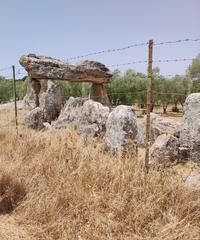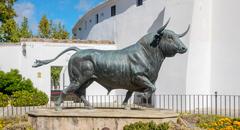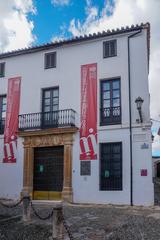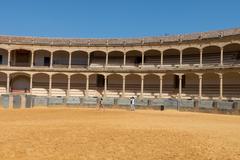
Puente Nuevo Ronda, Spain: Visiting Hours, Tickets, and Travel Guide
Date: 04/07/2025
Introduction
Puente Nuevo in Ronda, Spain, is one of Andalusia’s most iconic landmarks, renowned for its breathtaking architecture and panoramic views over the El Tajo Gorge. This 18th-century bridge not only connects Ronda’s historic Moorish quarter (La Ciudad) with its newer district (El Mercadillo), but it also stands as a symbol of the city’s resilience and unity. Towering 98 meters above the Guadalevín River, Puente Nuevo is a marvel of neoclassical engineering, featuring a central arch and a unique chamber that has served various purposes throughout history, including as a prison during the Spanish Civil War. Today, this chamber houses a small museum that offers insights into the bridge’s storied past.
This comprehensive guide details Puente Nuevo’s history, architectural significance, visiting hours, ticketing, accessibility, travel tips, and nearby attractions. Whether you’re a history enthusiast, architecture lover, or curious traveler, this article will help you make the most of your visit to this remarkable site. For additional planning resources, visit andalucia.com, AquaApple, and Andalucia Lovers.
Contents
- History of Puente Nuevo
- Architectural Significance
- Visiting Puente Nuevo: Hours, Tickets & Travel Tips
- Cultural and Historical Significance
- Legends and Stories
- Viewing Tips
- FAQ
- Conclusion
History of Puente Nuevo
Origins and Historical Context
Puente Nuevo (“New Bridge”) was constructed to address the growing needs of Ronda, replacing earlier bridges—the 12th-century Moorish Puente Árabe and the 16th-century Puente Viejo—that could no longer support the city’s expanding population and commerce. The first attempt to build Puente Nuevo in 1735 ended in tragedy when the structure collapsed, resulting in the loss of around 50 lives. Construction of the current bridge began in 1751 under architect José Martin de Aldehuela and master builder Juan Antonio Díaz Machuca, culminating in 1793 after 42 years of effort (andalucia.com).
Architectural Significance
Design and Construction
Puente Nuevo exemplifies neoclassical engineering, blending subtle Moorish influences. Spanning 98 meters above the Guadalevín River, it remains one of Spain’s tallest bridges (spanishplains.com). The central arch measures 35 meters, flanked by two smaller arches, with the entire structure built from locally quarried limestone. Innovative lifting machinery was used to hoist massive stones from the gorge, while the foundation incorporates remnants of the failed earlier structure reinforced with massive retaining walls (spanishplains.com).
Unique Features
A notable feature is the chamber within the central arch, which has served as a prison, guardhouse, and bar. During the Spanish Civil War, it gained notoriety as a detention site. Today, it is a museum recounting the bridge’s fascinating history (andalucia.com).
Visiting Puente Nuevo: Hours, Tickets & Travel Tips
Visiting Hours
- Bridge: Open to pedestrians 24/7, year-round.
- Chamber Museum/Interpretation Center: Generally open from 10:00 AM to 6:00 PM. Hours may vary by season; check local tourism sources for updates.
Tickets and Entry Fees
- Crossing the Bridge: Free of charge.
- Chamber Museum Admission: Approximately €2–3 per person (credit card only), with possible discounts for children, seniors, and groups. Tickets are available onsite.
Accessibility
- The bridge is accessible on foot, but the surrounding cobbled streets and steep terrain may be challenging for those with mobility issues. Wheelchairs and strollers can cross the main bridge, but not all viewpoints and museum sections are accessible (Andalucia Lovers).
Best Times to Visit
- Early Morning or Late Afternoon: Optimal lighting for photography and fewer crowds.
- Spring and Autumn: Pleasant weather and manageable visitor numbers.
- Sunset: The bridge is beautifully illuminated, and the atmosphere is more tranquil (Whats Down That Street).
Getting There
- By Car: Parking is limited; the Plaza del Socorro pay lot is recommended (Andalucia Lovers).
- By Train/Bus: Ronda is well connected to Málaga, Seville, and Granada. The bridge is a 10–15 minute walk from the station.
Guided Tours
Local operators offer walking tours that provide deep historical context and access to unique viewpoints. Booking ahead is recommended during peak periods (Visit Andalucia).
Cultural and Historical Significance
Puente Nuevo is more than an engineering feat; it is the heartbeat of Ronda, symbolizing unity, resilience, and transformation. The bridge’s construction marked a pivotal period in Ronda’s transition from Moorish stronghold to Christian city (AquaApple). During the Spanish Civil War, the bridge was used as a prison, and local legend tells of political prisoners being thrown into the gorge—a somber reminder of the city’s turbulent past (Unusual Places). Today, Puente Nuevo’s silhouette is featured in art, literature, and tourism materials, reinforcing its role as Ronda’s cultural icon (Ronda Today).
Annual festivals like the Feria de Pedro Romero use the bridge as a backdrop, and its panoramic views have inspired generations of artists, writers, and photographers (AquaApple; Landscapes Revealed).
Legends and Stories
Puente Nuevo’s dramatic setting has given rise to numerous legends, including tales of tragic executions and daring escapes during wartime. The museum shares stories blending historic fact and local folklore (andalucia.com).
Viewing Tips and Top Viewpoints
- Mirador de Aldehuela: Offers classic bridge views.
- Jardines de Cuenca: Terraced gardens ideal for sunrise photography (Wanderlust Chloe).
- Bottom of the Gorge: Via Camino de los Molinos trail, showcasing the bridge’s immense height (España Guide).
- Museums and Historic Houses: Palacio de Mondragón and Casa Museo Don Bosco provide unique elevated perspectives (Andalucia Lovers).
Photography Pro Tips:
Aim for sunrise or sunset for soft light and fewer tourists. Use a wide-angle lens to capture the full span and depth of the gorge.
Safety and Sustainability
- Safety: The bridge has sturdy railings, but caution is advised near edges, especially with children. Slippery surfaces are possible after rain.
- Sustainability: Vehicle access is restricted to local residents to reduce congestion and preserve the historic core. Visitors are encouraged to walk, use public transport, and support eco-friendly accommodations and local businesses (Visit Andalucia).
Nearby Attractions
- Plaza de Toros de Ronda: One of Spain’s oldest bullrings, with a museum.
- Mondragón Palace: Moorish architecture and gardens.
- Arab Baths and Casa del Rey Moro: Glimpses into medieval Moorish life.
- Church of Santa Maria la Mayor: Blend of Gothic and Baroque styles.
- El Tajo Gorge Walking Route: Offers panoramic perspectives of the bridge.
Additional Visitor Services
- Restrooms: None on the bridge; facilities available nearby.
- Restaurants and Cafés: Numerous options within walking distance, many with terrace views (Andalucia Lovers).
- Tourism Office: Personalized itineraries, accessibility information, and guided tours are available.
Frequently Asked Questions (FAQ)
Q: What are Puente Nuevo visiting hours?
A: The bridge is open 24/7 for pedestrians. The museum is generally open from 10:00 AM to 6:00 PM; check for seasonal variations.
Q: Is there an entry fee?
A: Walking the bridge is free. The museum admission is approximately €2–3 per person.
Q: Is the bridge accessible for people with disabilities?
A: The bridge itself is mostly accessible, but some viewpoints and museum areas may be challenging due to stairs and cobblestones.
Q: Can I park near Puente Nuevo?
A: Parking is limited; use the Plaza del Socorro pay lot.
Q: Are guided tours available?
A: Yes, guided tours can be booked in advance and often include other Ronda historical sites.
Q: When is the best time to visit?
A: Early morning or late afternoon for the best light and fewest crowds.
Conclusion
Puente Nuevo is a must-see historical site that offers breathtaking views, rich cultural insights, and a gateway to Ronda’s vibrant history. Plan your visit for early morning or sunset, explore nearby attractions, and consider guided tours for added context. Adhere to safety and sustainability guidelines to help preserve this marvel for future generations.
For real-time updates, exclusive guides, and audio tours, download the Audiala mobile app and follow us on social media for ongoing travel inspiration.
Internal Links
Sources and Further Reading
- Puente Nuevo Ronda: Visiting Hours, Tickets, History & Travel Tips, 2024, Andalucia.com (https://www.andalucia.com/ronda/puentenuevo.htm)
- Puente Nuevo Visiting Hours, Tickets, and Cultural Significance: Your Complete Guide to Ronda’s Iconic Bridge, 2024, AquaApple (https://aquaapple.com/ronda-spain-history/)
- Puente Nuevo Ronda Visiting Hours, Tickets, and Travel Guide, 2024, Andalucia Lovers (https://andalucialovers.com/en/visit-puente-nuevo-ronda/)
- Discover Puente Nuevo in Ronda: Visiting Hours, Tickets, Safety, and Nearby Attractions, 2025, Visit Andalucia (https://www.visit-andalucia.com/guide-to-ronda-malaga/)






